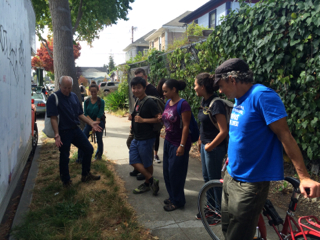
Share On Social!

Two University of California at Berkeley professors are hoping to prove that grocery stores and farmers’ markets aren’t the only places to find fresh fruits and vegetables. They’ve been taking students to food desert neighborhoods in the bay area to hunt for edibles grown in abandon lots, cracked sidewalks, and along chain linked fences.
The project, “Reaping without Sowing: Urban Foraging and Berkeley Open Source Food,” was launched by UC Berkeley ethnobotanist Tom Carlson and statistician Philip Stark. On four Thursdays this fall, they and a small group of student volunteers from Carlson’s medical ethnobotany course who are trained in medical and food plant identification roam for hours through three-square-block areas of food deserts in Richmond, Oakland or Berkeley. Using their cell phones and a mobile app called iNaturalist, created by UC Berkeley’s School of Information, they log project data that includes each species of plant they find, its location, photos, and how many serving sizes are available per address.
In urban food deserts, “people have diet-related disease not from lack of calories, but from eating too much of the wrong kinds of foods,” says Carlson in a news article. “One of the deficiencies is a lack of fruits, vegetables, leafy greens and phytochemicals,” which are naturally occurring chemical compounds in plants that can remedy some illnesses.
Carlson and Stark hope that the results of their on-going project could present one solution to getting underserved communities the nutrition they need for free.
Explore More:
Healthy Families & SchoolsBy The Numbers
142
Percent
Expected rise in Latino cancer cases in coming years



